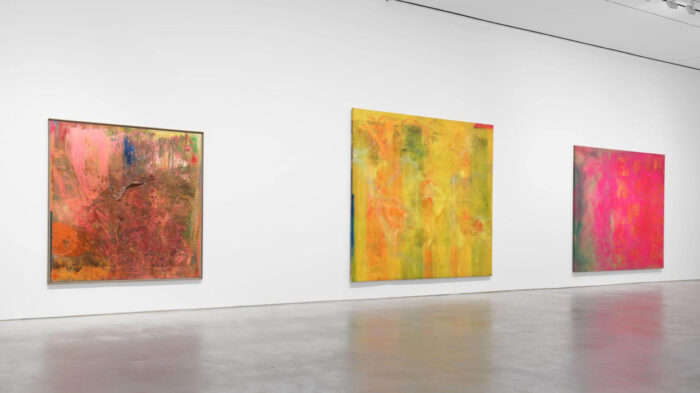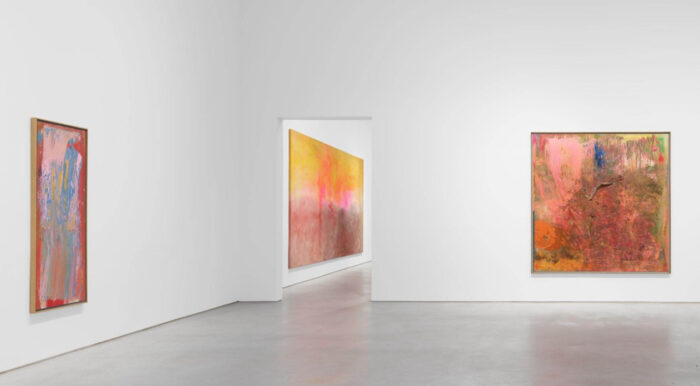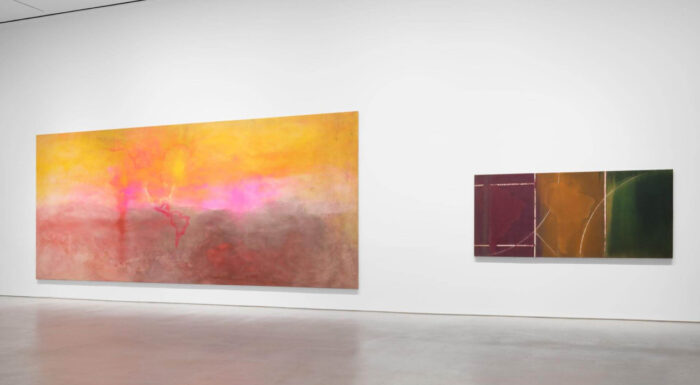Video walk-through of Frank Bowling at Hauser & Wirth (22nd street)





Frank Bowling at Hauser & Wirth in NYC (22nd St.)
May 31 – July 31, 2021
Images courtesy of Hauser & Wirth Gallery
Bowling’s transatlantic orientation reveals itself in a shift from his early engagement with expressive figuration and pop art, to an immersion in a uniquely poetic abstraction that continues to evolve even today. Visible in his work are the legacies of both the English landscape tradition and American abstract expressionism.
Developing in and between two cities over the course of decades, Bowling’s exploration of light, color, and geometry can be understood as profoundly influenced by the two great rivers of his life: he has maintained studios close to The Thames in London and the East River in New York, absorbing the brilliance of the rivers’ light into his vision.
Bowling would often begin a work in one city and finish it in the other, merging the atmospheres of both. In his own words, ‘I would just roll the lot up and move. And I knew that when I got to the other end, I could roll them out again and continue to work.’
Bowling’s restless innovation on the painted plane endures in his latest works. He continues to break ground through the use of thick impasto textures, acrylic gels, collage, stitched canvas, and metallic and pearlescent pigments. The complexities of his upbringing in Guyana and his constant journeying between London and New York have only served to activate the richness of the different influences of each location. His paintings are a celebration of a life lived in varying lights and colors.
In 1961, while attending the Royal College of Art, Bowling visited New York. It would be the first of frequent visits over the years, when he stayed and worked at the infamous Hotel Chelsea, the city’s unofficial clubhouse for artists, writers, poets, photographers, and musicians. Recognizing that New York City was the center of the art world, and the home base of an organized effort to achieve greater representation of Black artists in public institutions, Bowling felt compelled to migrate there.
In New York, Bowling befriended like-minded artists and was inspired to explore the medium of painting devoid of any figurative references, advancing his journey toward pure abstraction. The work of Jasper Johns, whose paintings with stenciled words and enigmatic images, made a significant impact upon Bowling in his search for new ways to experience and make art. As he says, ‘New York beckoned, and the toughness, competitive edge, and excitement drove me and my work to rise to new horizons’. Bowling’s position in New York was secured when he took a permanent studio on Broadway and was given a solo exhibition at the Whitney Museum of American Art in 1971.
Bowling moved to New York in 1966, a charged historical moment in which Black American artists were seeking commitment from the larger art world to the civil rights movement. Major museums were just beginning fledgling efforts to represent the richness of Black art and culture. As an active instigator of dialogue, Bowling addressed the critical invisibility of Black artists through a series of writings for Arts Magazine (1969 – 1972), making a significant contribution to intellectual discourse around Black art in America with essays on fellow artists Jack Whitten, Mel Edwards, and Al Loving.
In the summer of 1984, Bowling spent nine weeks as a resident artist-teacher at the renowned Skowhegan School of Art in Maine. It was here that he began to gather natural materials from the surrounding property, gluing them to the surface of his canvases and painting over them. In this magical rural setting, Bowling’s impressions of rivers, natural light, and terrain fused with his memories of classical English landscape painting. The effects can be seen in such works in the exhibition as ‘Armageddon’ (1984) and ‘Swissvisit I’ (1983).
It was Bowling’s constant movement between New York and London that led him to cut up canvases in order to transport them more easily; he would sometimes even attach a canvas to another work, with extra strips added to the cropped edges. In works such as ‘Jamsahibwall’ (1990), a seven-part work, this formal framing device extends into the painted ground area itself and demonstrates the pioneering spirit of Bowling’s approach to technique.
About the Artist
Over the course of six decades, Frank Bowling has relentlessly pursued a practice that boldly expands the possibilities and properties of paint. Ambitious in scale and scope, his dynamic engagement with the materiality of his chosen medium, and its evolution in the broad sweep of art history has resulted in paintings of unparalleled originality and power. Bowling has been hailed as one of the foremost British artists of his generation. Born in Guyana (then British Guiana) in 1934, he arrived in London in 1953, graduating from the Royal College of Art with the silver medal for painting in 1962.
